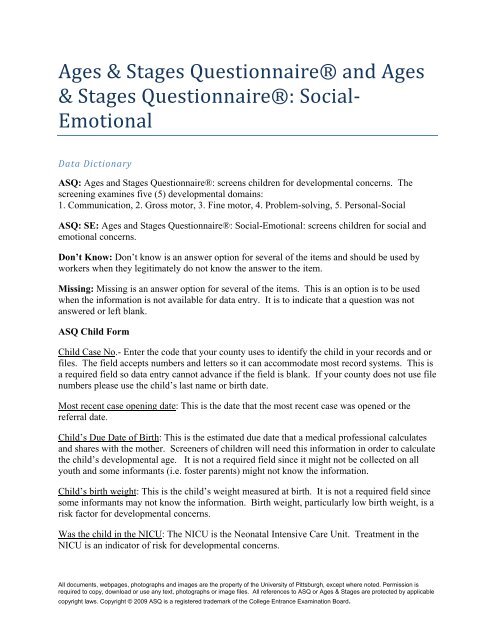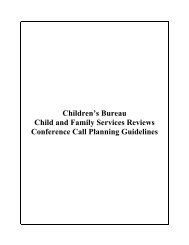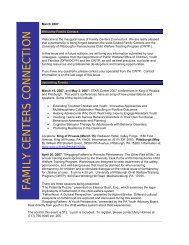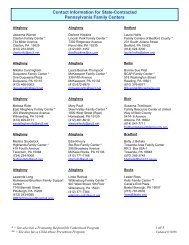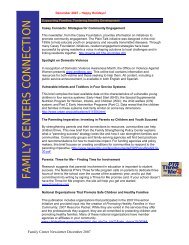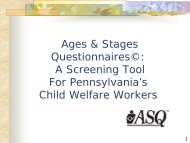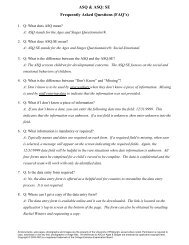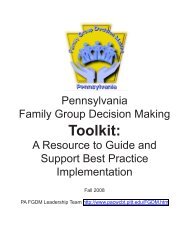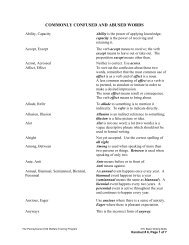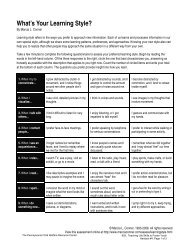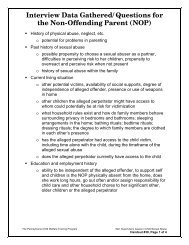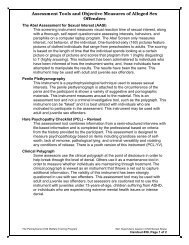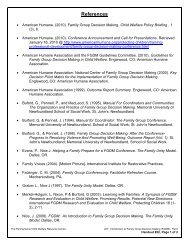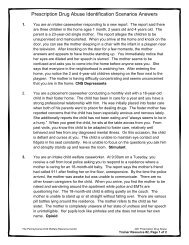Ages & Stages Questionnaire® and Ages & Stages Questionnaire
Ages & Stages Questionnaire® and Ages & Stages Questionnaire
Ages & Stages Questionnaire® and Ages & Stages Questionnaire
You also want an ePaper? Increase the reach of your titles
YUMPU automatically turns print PDFs into web optimized ePapers that Google loves.
<strong>Ages</strong> & <strong>Stages</strong> <strong><strong>Questionnaire</strong>®</strong> <strong>and</strong> <strong>Ages</strong><br />
& <strong>Stages</strong> <strong><strong>Questionnaire</strong>®</strong>: Social‐<br />
Emotional<br />
Data Dictionary<br />
ASQ: <strong>Ages</strong> <strong>and</strong> <strong>Stages</strong> <strong><strong>Questionnaire</strong>®</strong>: screens children for developmental concerns. The<br />
screening examines five (5) developmental domains:<br />
1. Communication, 2. Gross motor, 3. Fine motor, 4. Problem-solving, 5. Personal-Social<br />
ASQ: SE: <strong>Ages</strong> <strong>and</strong> <strong>Stages</strong> <strong><strong>Questionnaire</strong>®</strong>: Social-Emotional: screens children for social <strong>and</strong><br />
emotional concerns.<br />
Don’t Know: Don’t know is an answer option for several of the items <strong>and</strong> should be used by<br />
workers when they legitimately do not know the answer to the item.<br />
Missing: Missing is an answer option for several of the items. This is an option is to be used<br />
when the information is not available for data entry. It is to indicate that a question was not<br />
answered or left blank.<br />
ASQ Child Form<br />
Child Case No.- Enter the code that your county uses to identify the child in your records <strong>and</strong> or<br />
files. The field accepts numbers <strong>and</strong> letters so it can accommodate most record systems. This is<br />
a required field so data entry cannot advance if the field is blank. If your county does not use file<br />
numbers please use the child’s last name or birth date.<br />
Most recent case opening date: This is the date that the most recent case was opened or the<br />
referral date.<br />
Child’s Due Date of Birth: This is the estimated due date that a medical professional calculates<br />
<strong>and</strong> shares with the mother. Screeners of children will need this information in order to calculate<br />
the child’s developmental age. It is not a required field since it might not be collected on all<br />
youth <strong>and</strong> some informants (i.e. foster parents) might not know the information.<br />
Child’s birth weight: This is the child’s weight measured at birth. It is not a required field since<br />
some informants may not know the information. Birth weight, particularly low birth weight, is a<br />
risk factor for developmental concerns.<br />
Was the child in the NICU: The NICU is the Neonatal Intensive Care Unit. Treatment in the<br />
NICU is an indicator of risk for developmental concerns.<br />
All documents, webpages, photographs <strong>and</strong> images are the property of the University of Pittsburgh, except where noted. Permission is<br />
required to copy, download or use any text, photographs or image files. All references to ASQ or <strong>Ages</strong> & <strong>Stages</strong> are protected by applicable<br />
copyright laws. Copyright © 2009 ASQ is a registered trademark of the College Entrance Examination Board.
Is the child the subject or target child of a current referral to child welfare?: Some counties may<br />
conduct screenings on children in the home who were not the subject of the initial report to the<br />
Children <strong>and</strong> Youth Agency.<br />
Maltreatment Types:<br />
• Caregiver Substance Abuse<br />
• Caregiver’s Mental Health<br />
• Child behavior concerns<br />
o Child sexually acting out<br />
o Aggressive acts<br />
• Domestic violence in the home<br />
• Don’t Know<br />
• Failure to Protect<br />
o Failure to protect a child from a third party (i.e. child left with a known abuser)<br />
o Lack of parental control<br />
o Conduct by caregiver that places child at risk (i.e. exposure to illegal activites)<br />
• Lacking basic needs<br />
o Environmental concerns<br />
o Inadequate shelter<br />
o Inadequate food<br />
o Inadequate clothing<br />
o Inadequate health care<br />
o Inadequate hygiene<br />
• Other (explain in notes category)<br />
• Parenting concerns<br />
o Caregiver’s inability to cope<br />
o Inappropriate discipline<br />
o Caregiver/Child conflict<br />
• Physical abuse<br />
Any recent act or failure to act by a perpetrator that causes non-accidental<br />
serious physical injury to a child under 18 years of age i . Serious physical injury to a child is<br />
a physical condition that:<br />
o Causes severe pain; or<br />
o Significantly impairs functioning, either temporarily or permanently.<br />
• Physical maltreatment<br />
o Any behavior that does not meet the definitions of physical abuse.<br />
• Physical neglect<br />
All documents, webpages, photographs <strong>and</strong> images are the property of the University of Pittsburgh, except where noted. Permission is<br />
required to copy, download or use any text, photographs or image files. All references to ASQ or <strong>Ages</strong> & <strong>Stages</strong> are protected by applicable<br />
copyright laws. Copyright © 2009 ASQ is a registered trademark of the College Entrance Examination Board.
o Serious physical neglect by a perpetrator is prolonged or repeated lack of care or the<br />
failure to provide the essentials of life, including adequate medical care, which<br />
endangers a child's life or development or impairs the child's functioning<br />
• Serious mental or emotional abuse<br />
o Any act or failure to act by a perpetrator that causes non-accidental serious<br />
mental injury to a child under 18 years of age. Serious mental injury is a<br />
psychological condition, as diagnosed by a physician or licensed psychologist,<br />
including the refusal of appropriate treatment, that:<br />
o Renders a child chronically <strong>and</strong> severely anxious, agitated, depressed, socially<br />
withdrawn, psychotic or causes reasonable fear that the child's life or safety is<br />
threatened; or<br />
o Seriously interferes with a child's ability to accomplish age-appropriate<br />
developmental <strong>and</strong> social tasks.<br />
• Sexual abuse:<br />
o any act or failure to act by a perpetrator that causes sexual abuse or sexual<br />
exploitation of a child under 18 years of age ii ;<br />
o the employment, use, persuasion, inducement, enticement or coercion of a child<br />
to engage in or assist another individual to engage in sexually explicit conduct iii .<br />
o the employment, use, persuasion, inducement, enticement or coercion of a child<br />
to engage in or assist another individual to engage in simulation of sexually<br />
explicit conduct for the purpose of producing visual depiction, including<br />
photographing, videotaping, computer depicting <strong>and</strong> filming.<br />
o any of the following offenses committed against a child: rape iv , sexual assault v ,<br />
involuntary deviate sexual intercourse vi , aggravated indecent assault vii ,<br />
molestation, incest viii , indecent exposure ix , prostitution x , sexual abuse, sexual<br />
exploitation.<br />
• Sibling was primary referral; explain in notes category<br />
• Student Abuse:<br />
Serious bodily injury to or sexual abuse or exploitation of a student by an employee.<br />
(i.e. a teacher or a daycare provider).<br />
• Supervisory neglect:<br />
Includes, but is not limited to, the following situations or actions by a caregiver;<br />
o Children who are ab<strong>and</strong>oned or parent refuses to take care of the child.<br />
o Children who are left unsupervised or inadequately supervised.<br />
Are there additional children in this household being screened: Is there another child in the<br />
home that is also receiving an ASQ screening.<br />
All documents, webpages, photographs <strong>and</strong> images are the property of the University of Pittsburgh, except where noted. Permission is<br />
required to copy, download or use any text, photographs or image files. All references to ASQ or <strong>Ages</strong> & <strong>Stages</strong> are protected by applicable<br />
copyright laws. Copyright © 2009 ASQ is a registered trademark of the College Entrance Examination Board.
ASQ Caregiver Form<br />
Relationship to child: How is the caregiver related to the child?<br />
Caregiver’s highest level of education: This is the caregiver’s highest level of education. If a<br />
caregiver has a bachelor’s degree it is understood that they also have satisfied the requirements<br />
to receive a diploma or GED <strong>and</strong> so only the bachelor’s degree needs to be selected. Screeners<br />
generally collect education information on caregivers as part of the screening process.<br />
ASQ Entry Form<br />
Screening administered by: asks which agency conducted the screening.<br />
• Child Welfare staff- staff from the county’s children <strong>and</strong> youth agency<br />
• County MH/MR staff<br />
• Early Intervention provider- a private agency contracted by the county to conduct early<br />
intervention screenings <strong>and</strong> provide services.<br />
• Other- screener that does not belong in any of the previous categories. An example might<br />
be a private physician or a family center.<br />
• Don’t Know- use when it is unknown who conducted the screening.<br />
Screening methods: how did the screener gather the information to conduct the assessment?<br />
• Don’t Know: used when it is unknown what method was used<br />
• Interview: Discussion with the parent or caregiver that elicits information about what<br />
they have observed <strong>and</strong> experienced related to a child’s behavior <strong>and</strong> skills.<br />
• Observation: systematic recording of observations of the child's development/skills in<br />
order to make a determination about what has been learned <strong>and</strong> support children's<br />
progress.<br />
• Test: requiring the child to demonstrate a skill of behavior.<br />
Areas of concern: the ASQ evaluates five (5) developmental domains; these domains are the<br />
areas of concern.<br />
• Communication<br />
• Gross motor<br />
• Fine motor<br />
• None- there are no areas of concern <strong>and</strong> should be selected if there were no areas of<br />
concern.<br />
• Problem-solving<br />
• Personal-Social<br />
Date of Referral to EI: this is the date that the child was REFERRED for an MDT evaluation or<br />
other further evaluation; not the date of the MDT/other evaluation.<br />
All documents, webpages, photographs <strong>and</strong> images are the property of the University of Pittsburgh, except where noted. Permission is<br />
required to copy, download or use any text, photographs or image files. All references to ASQ or <strong>Ages</strong> & <strong>Stages</strong> are protected by applicable<br />
copyright laws. Copyright © 2009 ASQ is a registered trademark of the College Entrance Examination Board.
ASQ: SE Form<br />
Screening administered by: asks which agency conducted the screening.<br />
• Child Welfare staff- staff from the county’s children <strong>and</strong> youth agency<br />
• County MH/MR staff<br />
• Early Intervention provider- a private agency contracted by the county to conduct early<br />
intervention screenings <strong>and</strong> provide services.<br />
• Other- screener that does not belong in any of the previous categories. An example might<br />
be a private physician or a family center.<br />
• Don’t Know- use when it is unknown who conducted the screening.<br />
Areas of concern: the ASQ:SE screening assesses children’s social <strong>and</strong> emotional development.<br />
Each developmental assessment has established criteria <strong>and</strong> based on the child’s score which<br />
determines whether a referral for a further evaluation maybe indicated.<br />
• Did not meet the threshold: indicates that the child’s score did not exceed the threshold<br />
<strong>and</strong> a referral was NOT indicated.<br />
• Met the threshold: indicates that the child’s score met or exceeded the threshold <strong>and</strong> a<br />
referral was indicated.<br />
Screening methods: how did the screener gather the information to conduct the assessment?<br />
• Don’t Know: used when it is unknown what method was used<br />
• Interview: Discussion with the parent or caregiver that elicits information about what<br />
they have observed <strong>and</strong> experienced related to a child’s behavior <strong>and</strong> skills.<br />
• Observation: systematic recording of observations of the child's development/skills in<br />
order to make a determination about what has been learned <strong>and</strong> support children's<br />
progress.<br />
• Test: requiring the child to demonstrate a skill of behavior.<br />
Date of Referral to EI: this is the date that the child was REFERRED for an MDT evaluation or<br />
other further evaluation; not the date of the MDT/other evaluation.<br />
.<br />
All documents, webpages, photographs <strong>and</strong> images are the property of the University of Pittsburgh, except where noted. Permission is<br />
required to copy, download or use any text, photographs or image files. All references to ASQ or <strong>Ages</strong> & <strong>Stages</strong> are protected by applicable<br />
copyright laws. Copyright © 2009 ASQ is a registered trademark of the College Entrance Examination Board.
i Perpetrator‐ person who has committed child abuse <strong>and</strong> is: a parent of a child, a paramour of a child’s parent, an<br />
individual 14 years of age or older residing in the same homes as the child, A person responsible for the child’s<br />
welfare‐ this person maybe under the age of 14.<br />
ii Exploitation is any of the following: looking at the sexual or other intimate parts of a child for the purpose of<br />
arousing or gratifying sexual desire in either person, engaging or encouraging a child to look at the sexual or other<br />
intimate parts of another person for the purpose of arousing or gratifying sexual desire in any person involved,<br />
engaging or encouraging a child to participate in any sexually explicit conversation either in person, by telephone,<br />
by computer or computer aided device.<br />
iii Sexually explicit conduct is the employment, use , persuasion, inducement, enticement or coercion of any child<br />
to engage in or assist in any sexually explicit conduct, not just for the purposes of visual depiction.<br />
iv Engaging in sexual intercourse with a child: by forcible compulsion; by threat of forcible compulsion that would<br />
prevent resistance by a person of reasonable resolution; who is unconscious or where the perpetrator knows that<br />
the child is unaware that sexual intercourse is occurring; where the alleged perpetrator has substantially impaired<br />
the child’s power to appraise or control his or her conduct by administering or employing, without the knowledge<br />
of the child drugs, intoxicants or other means for the purpose of preventing resistance; who suffers from a mental<br />
disability which renders the child incapable of consent; or a child who is less than 13 years of age.<br />
v Engaging in sexual intercourse or deviate sexual intercourse with a child without the child’s consent.<br />
vi Engaging in deviate sexual intercourse with a child: by forcible compulsion, by threat of forcible compulsion that<br />
would prevent resistance by a person of reasonable resolution; the child is unconscious or the alleged perpetrator<br />
knows that the child is unaware the indecent contact is occurring; the alleged perpetrator has substantially<br />
impaired the child’s power to appraise or control his or her conduct by administering or employing, without the<br />
knowledge of the child, drugs, intoxicants, or other means for the purpose of preventing resistance; the child<br />
suffers from a mental disability which renders him or her incapable of consent; the child is less than 13 years of<br />
age; the child is less than 16 years or age <strong>and</strong> the perpetrator is for or more years older than the child <strong>and</strong> they are<br />
not married to each other.<br />
vii Engaging in penetration, however slight of the genitals or rectum of a child with a part of the perpetrator’s body<br />
for any purpose other than good faith medical, hygienic or law enforcement procedures: without the child’s<br />
consent; by forcible compulsion; by threat of forcible compulsion that would prevent resistance by a person of<br />
reasonable resolution; the child is unconscious or the alleged perpetrator knows that the child is unaware that the<br />
penetration is occurring; the alleged perpetrator has substantially impaired the child’s power to appraise or<br />
control his or her conduct by administering or employing, without the knowledge of the child, drugs, intoxicants or<br />
other means for the purpose of preventing resistance; the child suffers from a mental disability which renders him<br />
or her incapable of consent; the child is less than 13 years of age; the child is less than 16 years of age <strong>and</strong> the<br />
alleged perpetrator is four or more years older than the child <strong>and</strong> they are not married to each other.<br />
viii An alleged perpetrator who knowingly marries, cohabits or has sexual intercourse with an ancestor, descendant,<br />
a brother or sister of the whole or half blood, or an uncle, aunt, nephew or niece of the whole blood. The<br />
relationships referred to include blood relationships without regard to legitimacy, <strong>and</strong> relationship of parent <strong>and</strong><br />
child by adoption.<br />
ix Exposing of the genitals in any public place where there are other persons under circumstances that the alleged<br />
perpetrator knows or should know that this conduct is likely to offend, affront or alarm.<br />
x Any person who is an inmate of a house of prostitution or otherwise engaging in sexual activity as a business; or<br />
loitering in or within view of any public place for the purpose of being hired to engage in sexual activity.<br />
All documents, webpages, photographs <strong>and</strong> images are the property of the University of Pittsburgh, except where noted. Permission is<br />
required to copy, download or use any text, photographs or image files. All references to ASQ or <strong>Ages</strong> & <strong>Stages</strong> are protected by applicable<br />
copyright laws. Copyright © 2009 ASQ is a registered trademark of the College Entrance Examination Board.


